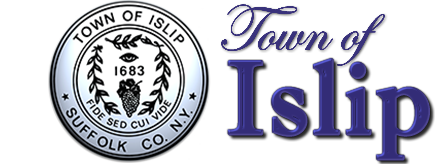INSIDE ISLIP TOWN Recycling
The Town of Islip processes 200-300 tons of recyclables every week. Residents may be surprised to know that the Town practices Reduce Reuse and Recycle in far more ways than just collecting bottles and cans or paper and cardboard.
Below, Department of Environmental Control Commissioner Martin Bellew breaks down the ins and outs of the Town of Islip's complex recycling process. Learn about why recycling is important, how the Town sorts items, what happens at the Multi-Purpose Recycling Center, as well as the many additional ways the Town continues to create and innovate environmental programs and waste management services that enhance and improve our community.
1. Overview
Our award-winning recycling program utilizes a dual stream method with an alternating collection schedule for paper and cardboard followed by metal, glass and plastic.
Recyclables are picked up curbside from Islip residences and brought to the Multi-Purpose Recycling Facility (MRF) also known as the WRAP Center located on Lincoln Avenue in Holbrook.
The employees at the facility regularly sort the material and remove contaminants such as garbage, Styrofoam and plastic bags. Once the material is sorted it is sent to recyclers who further process the material to be circulated back to manufacturers and eventually turned into new products.
2. Why is recycling important? What benefit does it serve?
Recycling is one of the best ways for us to have a positive impact on our environment.
When we recycle it reduces the amount of waste sent to landfills and incinerators, conserves natural resources such as timber, water and minerals, increases economic security by tapping a domestic source of materials, reduces the need to collect new raw materials, saves energy and cuts carbon emissions.
Recycling enables us to conserve valuable resources, and helps support American manufacturing by creating jobs in recycling and manufacturing industries.
3. Why does recycling collection alternate every other week between metal/glass/plastic and paper/carboard.
Separating waste is necessary to ensure that each recyclable item can go directly to a recycler that will accept and process the materials. View WRAP Calendar
Separating waste therefore reduces the incineration of residual waste. This reduces CO2 emissions, which in turn has a positive effect on the greenhouse effect. In addition, you save on raw materials because there is reuse and recycling. For example, fewer trees are cut for paper, less petroleum is needed to produce plastic and we need fewer metals for making tin and appliances.
4. Got to keep them separated!
It is critically important that everyone place only the approved materials in their WRAP recycling pails so that all of the items can be recycled.
View the Town of Islip Residential Collection and Disposal Guide HERE
When the recyclables are comingled with non-recyclable material they may be considered contaminated and might be rejected by the recyclers and end up at an incinerator or a landfill, despite our best efforts.
As a result, processing costs go up as it requires more effort to separate the materials.
5. Where does the recycling process begin?
The recycling process begins at home with our residents. The success of our recycling program depends on our community being willing to participate in the Town’s programs.
View WRAP Recycling Calendar
The Town depends on residents cleaning and sorting the correct material in order to make our recycling programs viable.
To assist residents in this endeavor the Town provides WRAP recycling pails, educational recycling calendars, annual recycling events such as STOP Day and Shredding Day, and the Town employs a recycling educator who teaches the next generation the benefits of “Reduce, Reuse, & Recycle”.
6. What happens after the Town collects recyclables?
Once collected, the sanitation carters deliver the recyclables to the Town’s Multi-Purpose Recycling Facility.
The employees at the facility sort the material and remove contaminants. View Waste Disposal Guide
The employees also sort out the high revenue items such as milk jugs, detergent containers, tin and cans to be sold to recyclers.
The materials are processed and prepared to be sent to a recycler who will further process the material to be sold to manufacturers to be turned into new products such as playground equipment, shopping bags, building insulation etc.
7. Explain the Multi-Purpose Recycling Facility
The Town of Islip Multi-Purpose Recycling Facility (also referred to as the MRF), provides expanded processing capability, and allows for recovery of a wide array of materials, as well as a higher percentage of quality product recovered.
The Town has developed a cost-effective recyclable handling and transfer facility for materials collected through its WRAP program, as well as related recyclables delivered to the facility by private vendors, and commercial & institutional establishments.
The building systems which comprise the facility include four (4) primary structures. Operations conducted within the structures include recyclables receiving, storage and processing. Also - and as part of the facility’s mission - is the public residential/commercial drop-off area.
8. What happens at the Multi-Purpose Recycling Facility?
The Multi-Purpose Recycling Facility accepts recyclables, household hazardous material, and electronics free of charge to Islip residents. Recycling materials collected at residences throughout the Town are sorted and processed at the facility and marketed to the recycling industry to dispose of the waste in an environmentally sound and valuable method. The facility also accepts non-recyclable material and household garbage for a fee. These items include kitchen garbage, appliances and furniture.
The facility was designed with two (2) primary processing lines for back-up redundancy and flexibility. Each line is rated an average of 10 tons per hours (tph). Based upon this total processing capability, the MRF has an equivalent weekly design capacity of 700 tons per week (tpw).
9. Contaminants are an ongoing challenge.
The biggest challenge the Town faces is incoming contaminants.
When residents place items in the WRAP pail that are not acceptable for recycling such as plastic bags, styrofoam or garbage it makes the sorting process more labor intensive and expensive.
View the Town of Islip Residential Collection and Disposal Guide HERE
This may also cause the material to be rejected by recyclers and increase the need to incinerate the residual waste.
10. It goes beyond collection.
The Town practices Reduce, Reuse and Recycle in far more ways than just collecting bottles, cans, paper and cardboard.
Through its various divisions, the Department of Environmental Control (DEC) manages the MacArthur Waste-to-Energy Facility which utilizes a mass burn technology to reduce the volume of solid waste by nearly 85% - 90% (excluding metals). The facility processes residential and commercial municipal solid waste at an average of 485 tons per day. Energy - in the form of super heated steam - is recovered to generate electrical power to not only operate the facility, but sell to the Long Island Power Authority (LIPA) as well.
11. The Compost Facility
The Town also operates a Compost Facility that accepts mixed yard waste from residents and landscapers. The yard waste is shredded, and processed and turned into a rich soil compost that can be used in organic farming, landscaping and gardening. Currently, all compost and mulch product produced annually at the facility is sold to commercial markets and given away - free of charge - to town residents.
The Town has also repurposed our closed and capped landfills into solar farms therefore creating a renewable and clean power-generation source on environmentally sensitive land.
12. The Shell Recycling Program
Likewise, the DEC participates in a shell recycling program by returning oyster shells from local restaurants to Long Island’s estuaries. The shells provide vitally important substrate on which young oysters can attach and grow, and they help to combat coastal acidification by returning calcium to the water.
Supervisor Angie Carpenter appointed a Sustainability Coordinator within the Department of Environmental Control to support the Town’s efforts to reaffirm our commitment to sustainable practices.
Useful Links & Resources
Back to Inside Islip Town

